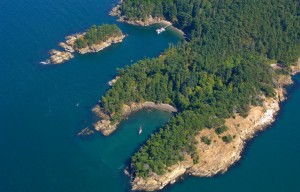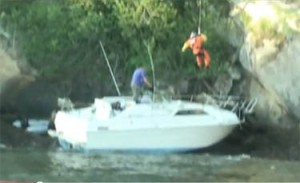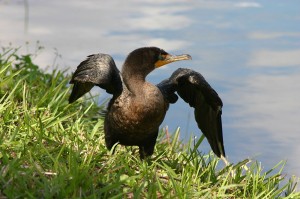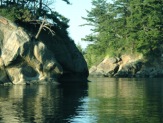Anchorage at beautiful Matia Island is enjoyable, yet it depends on favorable weather in Rolfe Cove. In 1792, Spanish explorer, Francisco de Eliza, accurately named the island Matia, meaning “no protection.” Exposed to northwest and west wind, waves can build and break an anchor free from the rocky bottom, sending a vessel on a collision course with a neighbor’s boat or worse…the shore. For this reason, every winter when stormy weather prevails between October and March, Washington State Marine Parks removes the dock and floats.
Photo courtesy of Washington’s Dept. of Ecology
Milder weather and vigilance do prevent most problems, but there are no guarantees. On July 26, 2010, a family of six were rescued by the U.S. Coast Guard when their Bayliner powerboat broke free of its mooring lines, grounded, and lay pinned against the island’s rock wall. A MH-65 Dolphin helicopter crew from Air Station Port Angeles hoisted the family, one member at a time, to the decks of private vessels. These boats ferried them to a 33-foot Coast Guard vessel that transported them to Bellingham with no reported injuries. A commercial company salvaged the boat. This photo is courtesy of the U.S. Coast Guard.
Photo courtesy of USCG – Wikimedia Commons
Fortunately, a calm sea mirrored the blue sky above our sailboat’s mast when we visited Matia Island, allowing us time to hike the mile-long Wilderness Loop Trail to see one of the few remaining stands of old-growth timber in the San Juan Islands. Designated a National Wildlife Refuge in 1940, the 145-acre island is home to colonies of migratory seabirds like Pigeon Guillemots, Double-crested Cormorants, and Pelagic Cormorants. If their shoreline nests are approached too closely, the birds will flush, leaving their eggs and chicks vulnerable to predators like seagulls and crows. Abandonment occurs if this happens repeatedly. Here is a Double-crested Cormorant.
Double-Crested Cormorant – Photo courtesy of Wikimedia Commons
In 1892, Elvin H. Smith built a snug cabin and lived for 30 years on Matia Island’s southeastern bay. Born in Wisconsin in 1835, he became embittered when his efforts during the American Civil War weren’t recognized. After a disappointing love relationship, he headed west, working as a newspaperman and agent for the Northern Pacific Railroad. In Bellingham, he joined a lawyer in land speculation to earn more money. Hearing rumors that the federal government was going to allow homesteading on Matia Island, his partner purchased land from a pair holding squatters’ rights and Smith moved to the island to perfect the claim. They planned to sell it for a profit in the future. But within two years, Smith knew he wanted to spend the rest of his life on the idyllic island with “its charming coves, sandy beaches, spring-fed lake, and ancient forests” and bought out his partner.
Photo courtesy of Wikimedia Commons
The bachelor raised chickens, rabbits, and sheep, fishing for salmon and cod by stringing a net across the narrow bay where he lived. He grew fruit and vegetables in the rich soil of the island’s valley. On Saturdays, he rowed two miles to Orcas Island, walking another two miles through the forest to the village of Eastsound to sell his goods, buy supplies, and collect his mail. Often he returned with a friend who’d come to visit. Was he a hermit? Probably not in the strict sense of the word, but the nickname others had given him stuck until his mid-80’s when he, George Carrier, and his small outboard-engine powered rowboat laden with supplies vanished in a storm on a return trip from Orcas Island on February 23, 1921.
Thanks for reading!
Blessings,
Deb






The story about the hermit of Matia Island can only be equaled by the life of another hermit, Ray Jewett, who lived alone on his half of Center Island.
I am an author and historian who knew Jewett. He moved to Center Island in about 1910. He built a small farm, where he raised goats and sheep, and lived as a hermit, until well into the 1940s.
Hi Mary, It’s good to meet you and learn about Ray Jewett’s life on Center Island. I enjoyed reading “An Unforeseen Journey” as it gave me a taste of what life was like when your family first settled on Decatur Island. We’ve anchored several times in Sylvan Cove and it’s one of our favorites. Thanks for sharing! Deb